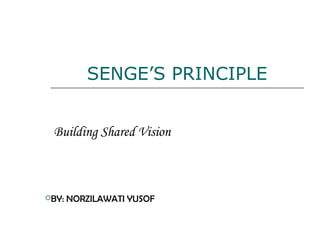
Shared vision
- 1. SENGE’S PRINCIPLE Building Shared Vision BY: NORZILAWATI YUSOF
- 2. Vision The vision is often a goal that the individual wants to reach. That goal must often a long term goal, sometimes that can be leading star for the individual. The shared vision of an organization must be built of the individual visions of its members. SHARING AN IMAGE OF THE FUTURE YOU WANT TO REALIZE TOGETHER (definition of Senge) Shared Vision
- 3. What does it means to have a shared vision? The practice of shared vision involves the skills of unearthing shared “pictures of the future” that foster genuine commitment and enrolment rather than compliance. In mastering this discipline, leaders learn the counter-productiveness of trying to dictate a vision, no matter how heartfelt. (Senge 1990)
- 4. What this mean for the leader….. in the learning organization is that the organizational vision must not be created by the leader, Rather.. The vision must be created through interaction with the individuals in organization
- 5. The leaders role in creating a SHARED VISION is: TO SHARE HER OWN VISION TO THE EMPLOYEES
- 6. The reality is…. Many leaders have personal visions that never get translated into shared visions that galvanize an organization… What has been lacking is a discipline for translating vision into shared vision
- 7. Only by compromising between the individual visions & the development of these visions in a common direction can the shared vision be created
- 8. How can someone start to share the organization’s vision? For a shared vision to develop, members of the organization must enroll in the vision. Senge (1990) stresses that vision can not be sold.
- 9. Reflection on SHARED VISION Brings the question of whether each individual in the organization must share the rest of the organization’s vision. The answer is…. NO… But…. The individuals who do not share the vision might not contribute as much to the organization.
- 10. Effect of SHARED VISION When there is a genuine vision, people excel and learn Not because they are told to do, BUT…because… THEY WANT TO When an organization has a shared vision, the driving force for change comes from what Senge calls “creative tension”. With truly committed members the creative tension will drive the organization towards its goals. Base on these visions, the organization’s should evolve
